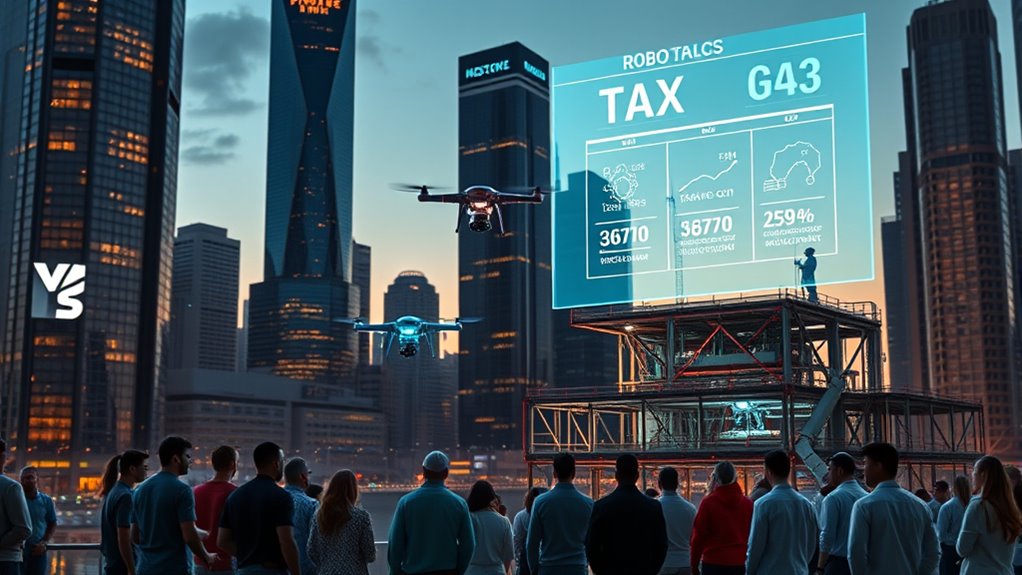As robots and AI take over many jobs, you might wonder who will fund society’s needs. Traditional taxes on income from work will decline, so governments are exploring options like robot taxes or levies on automation profits. You’ll learn how new revenue methods aim to guarantee that the benefits of automation are shared fairly and how policies can support displaced workers—if you want to understand how society can adapt, continue exploring these ideas.
Key Takeaways
- Automation reduces traditional tax revenues from income and labor taxes, necessitating new revenue models like robot or automation taxes.
- Wealth and capital income benefit disproportionately, increasing income inequality and challenging current tax systems.
- Policymakers are exploring innovative taxes on automation profits and data to fund public services sustainably.
- Revenue from automation-driven productivity gains may require shifts toward consumption taxes and alternative funding sources.
- Effective taxation policies must balance incentivizing innovation with ensuring societal costs are fairly shared.
The Rising Tide of Automation and Its Economic Impact

Automation is transforming the global economy at an unprecedented pace, with 70% of businesses increasing productivity, cutting costs, and boosting employee satisfaction through automation. You should know that AI could replace 300 million jobs worldwide, impacting 9.1% of all employment, and potentially affecting half of the global economy—about 1.2 billion jobs. Sectors like writing, photography, and software development are especially vulnerable to automation, yet many employers plan to train workers to work alongside AI. This surge in automation could add $4.4 trillion in productivity growth, according to McKinsey. While some jobs will be lost, new opportunities will emerge, especially in manufacturing and tech. The rapid adoption of automation tools is accelerating workforce transformation and economic shifts. The challenge lies in managing this rapid economic shift and ensuring a fair distribution of its benefits. Additionally, understanding the impact on employment is crucial for policymakers and workers alike to navigate this transition effectively. Recognizing the role of Personality Traits can also help in designing effective retraining programs and support systems for displaced workers. Furthermore, advances in AI’s role in Business Intelligence are enabling more informed decisions that can help mitigate some negative effects of automation on employment. Moreover, innovations in AI integration in healthcare are enhancing diagnostics and treatment options, which could lead to shifts in the healthcare workforce and job demands.
Challenges to Traditional Tax Systems in an Automated World

As automation advances, your tax system faces a shrinking base because fewer workers generate less income tax revenue. Meanwhile, capital income from investments and automation-related profits grows, shifting the tax burden away from labor. This imbalance challenges governments to find new ways to fund public services and address economic inequality. Implementing a robot tax could help realign fiscal policies by taxing the value generated by autonomous systems to sustain public revenue. Recognizing the importance of technological innovation in economic growth, policymakers are exploring innovative tax approaches to adapt to these changes. Additionally, understanding the economic implications of automation can guide the development of equitable and sustainable fiscal strategies. Incorporating sound design principles into public communication can enhance transparency and public understanding of these complex issues. Furthermore, understanding the social dynamics involved in economic shifts can facilitate more inclusive policy development. Emphasizing equitable wealth distribution may be essential in ensuring that automation benefits all segments of society rather than exacerbating disparities.
Shrinking Tax Base
The rise of automation is reshaping traditional tax systems by shrinking the tax base, primarily through the decline in labor income as robots and machines take over tasks once performed by humans. As automation replaces workers, tax revenues from income taxes decrease, especially in economies heavily reliant on labor. Different technologies and stages of adoption influence this impact, with early phases often causing more significant revenue drops. Additionally, automation leads to structural shifts, such as growth in service sectors, which may temporarily reduce tax collection. To sustain fiscal stability, you’ll need to contemplate tax policy reforms that address these changes, ensuring the system adapts to reduced labor income and evolving industrial compositions. Without adjustments, maintaining revenue levels will become increasingly challenging. This decline in labor-based revenue underscores the urgency for policymakers to rethink tax strategies in an automated economy. Moreover, understanding the impact of technological adoption can help shape effective policies for future economic stability. Recognizing the importance of a diversified tax base is crucial for building resilience against such disruptive technological shifts, as the shift toward automation also accelerates the adoption of advanced digital infrastructure. Furthermore, preparing for the long-term effects of automation requires a comprehensive approach to tax reform strategies that considers both immediate revenue impacts and future economic transformations. Additionally, fostering economic resilience through diversification can help mitigate the risks associated with a shrinking traditional tax base.
Capital Income Shift
In an automated economy, the demand for capital rises relative to labor, shifting income toward wealthier individuals and capital owners. This change increases the capital share in national income while decreasing labor’s share. You need to understand three key impacts:
- Wealth Inequality: Automation boosts returns for capital owners, widening the wealth gap. Wealth distribution becomes more unequal as the benefits of technological growth tend to concentrate among the already wealthy. The increasing prominence of capital income further exacerbates this disparity. Additionally, the durability and maintenance of assets like bicycles, which involve understanding bike components such as tires and gears, mirror the importance of maintaining capital assets in an automated economy. As automation advances, the need for specialized knowledge in asset management becomes increasingly vital for sustaining economic value. Moreover, the concentration of capital ownership can influence political and economic power structures, potentially leading to less equitable decision-making processes. Recognizing the role of technology-driven wealth is essential for understanding the broader economic shifts caused by automation.
- Tax Revenue Loss: Traditional taxes on labor and capital decline, reducing government income.
- Need for Policy Change: Tax systems must adapt, possibly incorporating new forms like robot or wealth taxes, to address the income shift.
This transformation challenges existing tax frameworks, making it essential to rethink how we distribute the economic gains from automation fairly. Without reforms, economic disparities could worsen, straining social stability.
Exploring New Revenue Models: Robot Taxes and Beyond

As automation advances, you’ll need to contemplate new ways to fund public services, like implementing robot levies or taxing automation gains. These strategies aim to distribute the benefits of AI and robotics more fairly while discouraging unchecked automation. Exploring alternative revenue models, such as taxing data or AI-driven profits, can help sustain government funding in a changing economy. Legislative proposals are already emerging to address these issues, reflecting the need for updated tax policies in the age of automation.
Implementing Robot Levies
Implementing robot levies offers a targeted approach to address the economic shifts caused by automation. By taxing companies that heavily rely on automation, you can help redistribute wealth and fund social programs. To make this effective, consider these key points:
- Focus on sectors where automation is most prevalent, like finance and data-driven industries.
- Design policies that balance innovation incentives with societal benefits, ensuring they don’t stifle progress.
- Adapt levies to different countries’ economic models, recognizing that approaches will vary globally.
- Incorporate portable camping solutions to help displaced workers adapt to new environments and opportunities, fostering resilience in communities. Additionally, leveraging AI security technologies can enhance the effectiveness of these policies by ensuring secure data management and monitoring of automation impacts. Understanding economic models used across nations can aid in tailoring policies that are both fair and sustainable. This strategy aims to maintain economic stability, promote fairness, and support displaced workers. Recognizing the importance of personality traits can facilitate more effective policy communication and implementation. While implementation challenges exist, a well-structured robot levy can serve as a crucial tool in reshaping how automation benefits society as a whole.
Taxing Automation Gains
Taxing automation gains presents an opportunity to develop new revenue models that go beyond traditional payroll and capital taxes. As automation replaces manual labor, your government’s reliance on labor income taxes declines, risking revenue shortfalls. While capital income taxes might rise, they’re often lower than labor taxes, limiting their effectiveness. Changes in demand and consumption also impact final goods taxes, adding complexity. To address this, policies aiming for tax neutrality—treating human and automated labor equally—can prevent distortions and maintain fairness. However, capital taxation remains challenging since capital income is taxed less and could discourage investment. Exploring alternative models, like taxing automation-produced profits or increasing consumption taxes, offers ways to capture gains from productivity, ensuring sustainable public funding in an era of widespread automation. Additionally, understanding how arcade machines operate can inform innovative approaches to digital and entertainment-related revenue streams. Recognizing the role of sustainable fashion and eco-friendly design in modern industries can inspire new avenues for sustainable revenue models in the evolving economy.
Alternative Revenue Strategies
With automation reshaping the economic landscape, exploring innovative revenue models becomes increasingly important. You can consider various approaches beyond traditional taxes, such as:
- Service-Based Subscriptions: Offering ongoing digital services or AI-driven solutions can generate steady income. These models often leverage recurring revenue streams to maintain financial stability.
- Robot Leasing and Maintenance: Leasing robots or providing maintenance services creates recurring revenue streams.
- Data Monetization: Selling insights from data generated by automation or offering cybersecurity and analytics services taps into new profit sources.
- Efficient General Ledger Coding: Implementing efficient ledger coding practices can streamline financial management and ensure accurate tracking of revenue from these new models.
These strategies not only diversify revenue but also align with the evolving digital economy. For example, usage-based pricing and licensing fees offer flexible models, while digital asset sales and eco-friendly incentives promote sustainable growth. Embracing these options helps you adapt to the future of automated industries.
Supporting Workers in Transition: Policies for a Changing Workforce

As automation continues to reshape the workforce, supporting workers through this shift becomes increasingly urgent. You’ll need policies that help displaced workers adapt quickly. Automation threatens 85 million jobs globally by 2025, especially in sectors like transport, where automation is rising. Only about 5% of affected workers transition out of at-risk jobs each decade, highlighting the need for ongoing retraining. Implementing skill development programs, redesigning jobs to blend human and automated tasks, and expanding accessible education are essential. Public support, including safety nets and subsidies for retraining, can ease the transition. Industry-led training and government partnerships further prepare workers for new roles. These strategies ensure you’re not left behind as automation advances, fostering a resilient, adaptable workforce.
Bridging the Gap: Addressing Economic Inequality in the Age of AI

Automation’s rapid spread reshapes economic landscapes, bringing both opportunities and challenges. You need to recognize that AI can both widen and narrow inequality, depending on who benefits. For example:
- Skilled and capital-owning groups gain more, increasing wealth gaps.
- High-AI adoption in wealthy countries boosts global disparities.
- Wage gaps grow as AI benefits some workers while threatening others.
You should understand that AI’s productivity gains tend to favor capital owners over workers, often deepening wealth concentration. Meanwhile, workers exposed to AI may earn higher wages, but mid-skill jobs face downward pressure, widening wage polarization. Addressing inequality requires policies that ensure AI benefits are shared more broadly, balancing growth with social fairness. Failing to act risks deepening existing divides and social tensions.
Shaping the Future: International Cooperation and Policy Innovation

Building effective international cooperation is essential to shaping a future where AI benefits everyone. You need clear regulatory frameworks to support AI adoption, including international standards that foster cross-border collaboration and innovation. Initiatives like OECD and G20 AI principles provide responsible governance models to guarantee accountability and safety across industries. Developing legal frameworks that address AI’s societal impact is equally crucial. Promoting global partnerships, such as the Global Partnership on AI, helps uphold human rights and responsible development. Collaborative networks and international forums encourage shared learning and innovation. By fostering cross-sector cooperation among governments, industries, and civil society, you can align AI advancements with societal goals. These efforts will create a resilient, inclusive digital ecosystem, ensuring AI’s benefits reach all populations worldwide.
Frequently Asked Questions
How Will Automation Affect Global Economic Inequality Long-Term?
You might see automation increasing global economic inequality long-term, as wealth concentrates among capital owners and high-skilled workers benefit more. Displaced workers could face stagnant wages and fewer opportunities, especially in developing countries. To prevent this, you’ll need policies like fair taxation, education, and social safety nets. By actively supporting equitable growth and global cooperation, you can help guarantee automation benefits everyone, not just a few.
What Ethical Considerations Surround Taxing Robots and Automated Systems?
Did you know that over 85% of jobs could be impacted by automation? When you consider taxing robots and automated systems, ethical issues arise. You must think about fairness—are we rewarding innovation without widening inequality? Responsibility also matters—should robots be accountable? Balancing progress with social justice is key, ensuring automation benefits everyone without unfairly displacing workers or creating new biases.
Can Universal Basic Income Sustainably Support Displaced Workers?
You might wonder if UBI can sustainably support displaced workers. It can, if funded through stable sources like automation taxes on corporations benefiting from AI. By providing a safety net, UBI helps maintain economic stability and encourages retraining. However, its long-term success depends on equitable implementation, political support, and complementary policies like skill development. When these elements align, UBI can be a durable solution for workers affected by automation.
How Might International Laws Regulate Cross-Border Automation Tax Avoidance?
Like Atlas bearing the weight of the world, you recognize the challenge of regulating cross-border automation tax avoidance. International laws could evolve through stronger cooperation, unified policies, and digital taxation frameworks, ensuring companies can’t exploit gaps. Updating treaties and applying global minimum tax rates would curb profit shifting. You see the importance of adaptive legislation and shared standards to hold multinational entities accountable, fostering fairness in the digital economy’s global landscape.
What Role Should Governments Play in Managing Automation-Driven Economic Change?
You should see that governments play a pivotal role in managing automation-driven change. They need to create policies that support workers, like retraining programs and stronger social safety nets. By implementing fair tax systems and encouraging innovation, they can balance economic growth with job security. Your government also has to regulate automation responsibly and promote international cooperation to guarantee a fair, sustainable transition for all citizens.
Conclusion
As you navigate this brave new world, remember that relying solely on old-world taxes is like using a quill in a digital age. You must rethink how society funds itself when robots handle most work. Embrace innovative policies, foster global cooperation, and support workers through this changeover. Only then can we guarantee fairness and prosperity for all, rather than watching the future, like a silent movie, pass us by.









